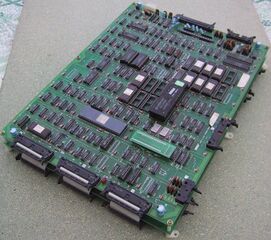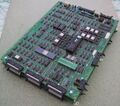Difference between revisions of "Sega Hang-On hardware"
From Sega Retro
| Line 18: | Line 18: | ||
This was the first in Sega's Super Scaler series of [http://gaming.wikia.com/wiki/Two-and-a-half-dimensional pseudo-3D] arcade hardware (followed by the [[Sega OutRun hardware|Sega OutRun]], [[Sega X Board]], [[Sega Y Board]] and [[Sega System 32]]). At the time of its release, this was the most powerful game system.{{ref|http://retro.ign.com/articles/974/974695p3.html}} | This was the first in Sega's Super Scaler series of [http://gaming.wikia.com/wiki/Two-and-a-half-dimensional pseudo-3D] arcade hardware (followed by the [[Sega OutRun hardware|Sega OutRun]], [[Sega X Board]], [[Sega Y Board]] and [[Sega System 32]]). At the time of its release, this was the most powerful game system.{{ref|http://retro.ign.com/articles/974/974695p3.html}} | ||
| − | The pseudo-3D [http://graphics.wikia.com/wiki/Sprite sprite]/[[wikipedia:Tile engine|tile]] scaling in Sega's Super Scaler arcade games were handled in a similar manner to textures in later [[wikipedia:Texture mapping|texture-mapped]] [http://gaming.wikia.com/wiki/Three-dimensional polygonal 3D] games of the 1990s.{{ref|http://www.extentofthejam.com/pseudo/}} Designed by [[Sega AM2]]'s [[Yu Suzuki]], he stated that his "designs were always 3D from the beginning. All the calculations in the system were 3D, even from Hang-On. I calculated the position, scale, and zoom rate in 3D and converted it backwards to [http://gaming.wikia.com/wiki/Two-dimensional 2D]. So I was always thinking in 3D."{{ref|http://web.archive.org/web/20131113174154/http://www.1up.com/features/disappearance-suzuki-part-1}} ''Hang-On'' was controlled using a [http://gaming.wikia.com/wiki/Video_game_arcade_cabinet video game arcade cabinet] resembling a [[wikipedia:Motorbike|motorbike]], which the player moved with their body. This began the "Taikan" trend, the use of [http://www.giantbomb.com/motion-control/3015-474/ motion-controlled] arcade cabinets in many arcade games of the late 1980s, two decades before motion controls became popular on [[game console]]s.{{ref|http://web.archive.org/web/20131113173854/http://www.1up.com/features/disappearance-suzuki-part-1}} | + | The pseudo-3D [http://graphics.wikia.com/wiki/Sprite sprite]/[[wikipedia:Tile engine|tile]] scaling in Sega's Super Scaler arcade games were handled in a similar manner to textures in later [[wikipedia:Texture mapping|texture-mapped]] [http://gaming.wikia.com/wiki/Three-dimensional polygonal 3D] games of the 1990s.{{ref|http://www.extentofthejam.com/pseudo/}} Designed by [[Sega AM2]]'s [[Yu Suzuki]], he stated that his "designs were always 3D from the beginning. All the calculations in the system were 3D, even from Hang-On. I calculated the position, scale, and zoom rate in 3D and converted it backwards to [http://gaming.wikia.com/wiki/Two-dimensional 2D]. So I was always thinking in 3D."{{ref|http://web.archive.org/web/20131113174154/http://www.1up.com/features/disappearance-suzuki-part-1}} |
| + | |||
| + | ''Hang-On'' was controlled using a [http://gaming.wikia.com/wiki/Video_game_arcade_cabinet video game arcade cabinet] resembling a [[wikipedia:Motorbike|motorbike]], which the player moved with their body. This began the "Taikan" trend, the use of [http://www.giantbomb.com/motion-control/3015-474/ motion-controlled] arcade cabinets in many arcade games of the late 1980s, two decades before motion controls became popular on [[game console]]s.{{ref|http://web.archive.org/web/20131113173854/http://www.1up.com/features/disappearance-suzuki-part-1}} | ||
==Technical Specifications== | ==Technical Specifications== | ||
Revision as of 20:50, 21 February 2015

| |||||
| Sega Hang-On hardware | |||||
|---|---|---|---|---|---|
| Manufacturer: Sega | |||||
|
Sega Hang-On hardware is an arcade system produced by Sega in 1985. It has no official name, but debuted with Hang-On (from which the name comes from) and went on to power several bike racing games of the mid-to-late 1980s. It is alternatively known as the Sega Space Harrier hardware, named after Space Harrier which released later in 1985.
The system specifications are similar to those of the Sega System 16, but has a stronger focus on graphics, adding a second of a second 68000 processor and a separate video board. Sega Hang-On hardware acts primarily as an advancement over the VCO Object board - it was designed to scale a large number of sprites in real-time, allowing for the creation of "pseudo-3D" graphics, in which a game can simulate a player moving towards the screen. At the time of release, this technology was considered groundbreaking, and would go on to fuel the Sega OutRun hardware specification as well as X Board and Y Board systems.
As this board was designed to serve one purpose, only five games were produced to make use of this system, all of which opt for the third-person perspective.
Hardware
This was the first in Sega's Super Scaler series of pseudo-3D arcade hardware (followed by the Sega OutRun, Sega X Board, Sega Y Board and Sega System 32). At the time of its release, this was the most powerful game system.[1]
The pseudo-3D sprite/tile scaling in Sega's Super Scaler arcade games were handled in a similar manner to textures in later texture-mapped polygonal 3D games of the 1990s.[2] Designed by Sega AM2's Yu Suzuki, he stated that his "designs were always 3D from the beginning. All the calculations in the system were 3D, even from Hang-On. I calculated the position, scale, and zoom rate in 3D and converted it backwards to 2D. So I was always thinking in 3D."[3]
Hang-On was controlled using a video game arcade cabinet resembling a motorbike, which the player moved with their body. This began the "Taikan" trend, the use of motion-controlled arcade cabinets in many arcade games of the late 1980s, two decades before motion controls became popular on game consoles.[4]
Technical Specifications
- Main CPU: Motorola MC68000 & Hitachi FD1094 (Motorola 68000)[5] @ 10 MHz[6] (16-bit & 32-bit instructions @ 3.5 MIPS)[7]
- MCU: Intel i8751 @ 8 MHz (Space Harrier)[6] (8-bit instructions @ 8 MIPS)[8]
- Sound CPU: Z80 @ 4 MHz[6] (8-bit & 16-bit instructions @ 0.58 MIPS)[7]
- Sound board: Sega 834-5670[5]
- Sound chips:
- FM synthesis chip: Yamaha YM2151 @ 4 MHz[6] (8 FM channels)
- PCM chip: SegaPCM[6] (315-5218[9]) @ 4 MHz[5] (stereo output, 16 PCM channels, 12-bit audio,[10] 31.25 kHz sampling rate[6])
- GPU: Sega Super Scaler chipset
- Graphics chips: 315-5011 sprite line comparator, 315-5012 sprite generator, 2× 315-5049 tilemap chips, 2x 315-5107 horizontal timing control, 315-5108 vertical timing control, 315-5122 timing chip[11]
- Performance: 12.5874 MHz sprite line buffer render clock, 6.2937 MHz sprite line buffer scan/erase & pixel clock[12]
- Video resolution: 320×224 (display), 400×262[5] (overscan), progressive scan (non-interlaced)
- Frame rate: 60 frames per second[13]
- Color palette: 32,768 (Hang-On), or 98,304 (Space Harrier, Enduro Racer)
- Sega's 16-bit arcade color palette: 15-bit RGB high color depth (32,768 colors) and 1-bit shadow & highlight that triples up to 98,304 colors.[11][14][10]
- Colors on screen: 6144[5]
- Graphical planes:[6]
- 2 tilemap layers: Row & column scrolling[14]
- Text layer
- Sprite layer: Hardware sprite-scaling
- Road layer: 512×256 resolution[2]
- Translucent shadows (Space Harrier)[11]
- Sprite capabilities: Hardware sprite-scaling, 128 sprites on screen per frame,[13] thousands of sprites scaled per second,[15] dual line buffers, double buffering,[12] 800 sprite pixels/texels (800.75 sprite processing ticks) per scanline, 100 sprites per scanline,[12] 8[16] to 256[12] width, 8[16] to 256[12] height
Gallery
List of Games
- Enduro Racer (1986)
- Hang-On (1985)
- Space Harrier (1985)
- Super Hang-On (1987)
- Limited Edition Hang-On (1991)
| Sega arcade boards |
|---|
| Originating in arcades |
|
77
78
79
80
81
82
83
84
85
86
87
88
89
90
91
92
93
94
95
96
97
98
99
|
| Console-based hardware |
|
84
85
86
87
88
89
90
91
92
93
94
95
96
97
98
99
00
01
02
03
04
05
06
07
08
09
10
11
12
13
14
|
| PC-based hardware |
|
05
06
07
08
09
10
11
12
13
14
15
16
17
18
19
20
21
22
23
|

